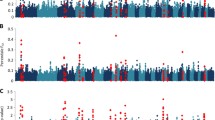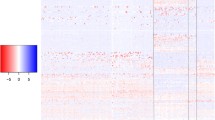Abstract
Genomic structural variation is an important and abundant source of genetic and phenotypic variation. We report an initial analysis of copy number variations (CNVs) in cattle selected for resistance or susceptibility to intestinal nematodes. We performed three array comparative genomic hybridization (CGH) experiments to compare Angus cattle with extreme phenotypes for fecal egg count and serum pepsinogen level. We identified 20 CNVs in total, of which 12 were within known chromosomes harboring or adjacent to gains or losses. About 85% of the CNV identified (17/20) overlapped with cattle CNV regions that were reported recently. Selected CNVs were further validated by independent methods using quantitative PCR (qPCR) and FISH. Pathway analyses indicated that annotated cattle genes within these variable regions are particularly enriched for immune function affecting receptor activities, signal transduction, and transcription. Analysis of transcription factor binding sites (TFBS) within the promoter regions of differentially expressed genes suggested that common transcription factors are probably involved in parasite resistance. These results provide valuable hypotheses for the future study of cattle CNVs underling economically important health and production traits.


Similar content being viewed by others

References
Araujo RN, Padilha T, Zarlenga D, Sonstegard T, Connor EE et al (2009) Use of a candidate gene array to delineate gene expression patterns in cattle selected for resistance or susceptibility to intestinal nematodes. Vet Parasitol 162:106–115
Bae JS, Cheong HS, Kim LH, NamGung S, Park TJ et al (2010) Identification of copy number variations and common deletion polymorphisms in cattle. BMC Genomics 11:232
Bailey TL, Gribskov M (1998) Methods and statistics for combining motif match scores. J Comput Biol 5:211–221
Conrad DF, Pinto D, Redon R, Feuk L, Gokcumen O et al (2009) Origins and functional impact of copy number variation in the human genome. Nature 464:704–712
Coppieters W, Mes TH, Druet T, Farnir F, Tamma N et al (2009) Mapping QTL influencing gastrointestinal nematode burden in Dutch Holstein-Friesian dairy cattle. BMC Genomics 10:96
Crawford AM, Paterson KA, Dodds KG, Diez TC, Williamson PA et al (2006) Discovery of quantitative trait loci for resistance to parasitic nematode infection in sheep: I. analysis of outcross pedigrees. BMC Genomics 7:178
Diez-Tascon C, Keane OM, Wilson T, Zadissa A, Hyndman DL et al (2005) Microarray analysis of selection lines from outbred populations to identify genes involved with nematode parasite resistance in sheep. Physiol Genomics 21:59–69
Fadista J, Thomsen B, Holm LE, Bendixen C (2010) Copy number variation in the bovine genome. BMC Genomics 11:284
Gasbarre LC, Leighton EA, Sonstegard T (2001) Role of the bovine immune system and genome in resistance to gastrointestinal nematodes. Vet Parasitol 98:51–64
Geiman DE, Ton-That H, Johnson JM, Yang VW (2000) Transactivation and growth suppression by the gut-enriched Kruppel-like factor (Kruppel-like factor 4) are dependent on acidic amino acid residues and protein-protein interaction. Nucleic Acids Res 28:1106–1113
Gupta S, Stamatoyannopoulos JA, Bailey TL, Noble WS (2007) Quantifying similarity between motifs. Genome Biol 8:R24
Hromas R, Collins S, Hickstein D, Raskind W, Deaven LP et al (1991) A retinoic acid-responsive human zinc finger gene, MZF-1, preferentially expressed in myeloid cells. J Biol Chem 266:14183–14187
Ingham A, Reverter A, Windon R, Hunt P, Menzies M (2008) Gastrointestinal nematode challenge induces some conserved gene expression changes in the gut mucosa of genetically resistant sheep. Int J Parasitol 38:431–442
Kaczynski J, Cook T, Urrutia R (2003) Sp1- and Kruppel-like transcription factors. Genome Biol 4:206
Kanehisa M, Goto S, Furumichi M, Tanabe M, Hirakawa M (2010) KEGG for representation and analysis of molecular networks involving diseases and drugs. Nucleic Acids Res 38:D355–D360
Keane OM, Zadissa A, Wilson T, Hyndman DL, Greer GJ et al (2006) Gene expression profiling of naive sheep genetically resistant and susceptible to gastrointestinal nematodes. BMC Genomics 7:42
Kennedy MW (1990) Resistance to parasitic nematodes––how is the MHC involved? Parasitol Today 6:374–375
Le Mee S, Fromigue O, Marie PJ (2005) Sp1/Sp3 and the myeloid zinc finger gene MZF1 regulate the human N-cadherin promoter in osteoblasts. Exp Cell Res 302:129–142
Li RW, Gasbarre LC (2009) A temporal shift in regulatory networks and pathways in the bovine small intestine during Cooperia oncophora infection. Int J Parasitol 39:813–824
Li RW, Sonstegard TS, Van Tassell CP, Gasbarre LC (2007) Local inflammation as a possible mechanism of resistance to gastrointestinal nematodes in Angus heifers. Vet Parasitol 145:100–107
Liu GE, Van Tassell CP, Sonstegard TS, Li RW, Alexander LJ et al (2008) Detection of germline and somatic copy number variations in cattle. Dev Biol 132:231–237
Liu GE, Ventura M, Cellamare A, Chen L, Cheng Z et al (2009) Analysis of recent segmental duplications in the bovine genome. BMC Genomics 10:571
Liu GE, Hou Y, Zhu B, Cardone MF, Jiang L et al (2010) Analysis of copy number variations among diverse cattle breeds. Genome Res 20:693–703
Manolio TA, Collins FS, Cox NJ, Goldstein DB, Hindorff LA et al (2009) Finding the missing heritability of complex diseases. Nature 461:747–753
McCarroll SA (2008) Extending genome-wide association studies to copy-number variation. Hum Mol Genet 17:R135–R142
Menzies M, Reverter A, Andronicos N, Hunt P, Windon R et al (2010) Nematode challenge induces differential expression of oxidant, antioxidant and mucous genes down the longitudinal axis of the sheep gut. Parasite Immunol 32:36–46
Redon R, Ishikawa S, Fitch KR, Feuk L, Perry GH et al (2006) Global variation in copy number in the human genome. Nature 444:444–454
Rowland BD, Peeper DS (2006) KLF4, p21 and context-dependent opposing forces in cancer. Nat Rev Cancer 6:11–23
Sandelin A, Alkema W, Engstrom P, Wasserman WW, Lenhard B (2004) JASPAR: an open-access database for eukaryotic transcription factor binding profiles. Nucleic Acids Res 32:D91–D94
Scherer SW, Lee C, Birney E, Altshuler DM, Eichler EE et al (2007) Challenges and standards in integrating surveys of structural variation. Nat Genet 39:S7–S15
Smith WD, Zarlenga DS (2006) Developments and hurdles in generating vaccines for controlling helminth parasites of grazing ruminants. Vet Parasitol 139:347–359
Solomon SS, Majumdar G, Martinez-Hernandez A, Raghow R (2008) A critical role of Sp1 transcription factor in regulating gene expression in response to insulin and other hormones. Life Sci 83:305–312
Sonstegard TS, Gasbarre LC (2001) Genomic tools to improve parasite resistance. Vet Parasitol 101:387–403
Sonstegard TS, Garrett WM, Ashwell MS, Bennett GL, Kappes SM et al (2000) Comparative map alignment of BTA27 and HSA4 and 8 to identify conserved segments of genome containing fat deposition QTL. Mamm Genome 11:682–688
Stranger BE, Forrest MS, Dunning M, Ingle CE, Beazley C et al (2007) Relative impact of nucleotide and copy number variation on gene expression phenotypes. Science 315:848–853
Thiagalingam A, Lengauer C, Baylin SB, Nelkin BD (1997) RREB1, a ras responsive element binding protein, maps to human chromosome 6p25. Genomics 45:630–632
Wheeler TT, Hood KA, Maqbool NJ, McEwan JC, Bingle CD et al (2007) Expansion of the bactericidal/permeability increasing-like (BPI-like) protein locus in cattle. BMC Genomics 8:75
Zhang F, Gu W, Hurles ME, Lupski JR (2009) Copy number variation in human health, disease, and evolution. Annu Rev Genomics Hum Genet 10:451–481
Website References
Cattle CNV: http://bfgl.anri.barc.usda.gov/cattleCNV/
Database of Genomic Variants: http://projects.tcag.ca/variation/
Ensembl genes: ftp://ftp.ensembl.org/pub/current_fasta/bos_taurus/pep/
JASPAR: http://jaspar.genereg.net/
MEME: http://meme.nbcr.net/
NimbleGen: http://www.nimblegen.com/
PANTHER: http://www.pantherdb.org/
Primer3: http://frodo.wi.mit.edu/primer3/
Acknowledgments
We thank J. Castano for technical assistance. This work was supported in part by NRI grant No. 2007-35205-17869 from USDA CSREES (now NIFA).
Author information
Authors and Affiliations
Corresponding author
Electronic supplementary material
Below is the link to the electronic supplementary material.
Rights and permissions
About this article
Cite this article
Liu, G.E., Brown, T., Hebert, D.A. et al. Initial analysis of copy number variations in cattle selected for resistance or susceptibility to intestinal nematodes. Mamm Genome 22, 111–121 (2011). https://doi.org/10.1007/s00335-010-9308-0
Received:
Accepted:
Published:
Issue Date:
DOI: https://doi.org/10.1007/s00335-010-9308-0



